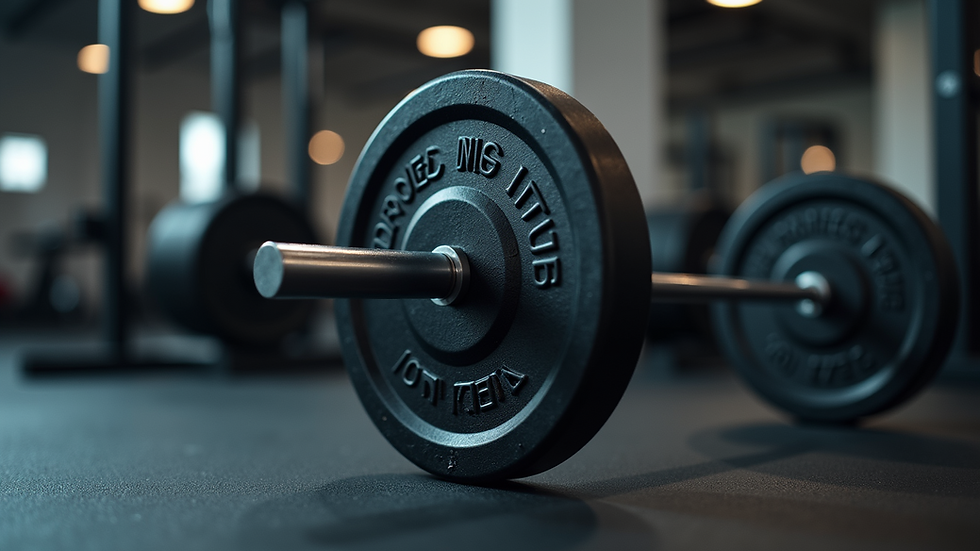ARE YOU A TEN? - THE 10RM WEIGHTLIFTING METHOD
- Moran Sciamama-Saghiv
- Aug 28
- 4 min read
Updated: Aug 29
Are you ready to level up your weightlifting game? The world of strength training offers many methods, but the 10RM (10 Repetition Maximum) technique is a standout for anyone, from novices to seasoned athletes. This popular approach not only builds strength but also enhances endurance, making it a favored choice for many. In this post, we will explore how to use the 10RM method effectively, the benefits it brings, and the best strategies to reach your fitness goals.
Understanding the 10RM Weightlifting Method
The 10RM method refers to the most weight a person can lift for ten consecutive repetitions. This technique is effective for two main reasons: it promotes muscular endurance and allows for muscle growth. According to research, training in this range can lead to a 48% increase in muscular endurance over a span of just eight weeks, making it a valuable addition to your workouts.
This approach is based on the principle of progressive overload. To build strength and muscle, you need to continually challenge your muscles. By identifying your 10RM, you can adjust your training to ensure you're lifting enough weight to stimulate growth while minimizing the risk of injury.
Benefits of the 10RM Weightlifting Method
1. Enhanced Muscular Endurance
Training with the 10RM method primarily improves your muscular endurance. For instance, athletes who regularly use this method have reported being able to perform activities, like running or cycling, not only longer but with less fatigue. This enables you to excel in both weightlifting and other athletic endeavors.
2. Balanced Muscle Development
The 10RM method promotes balanced development across multiple muscle groups within a single workout. For example, if you include exercises like squats, deadlifts, and bench presses in one session, you can enhance your overall physical appearance and functional strength. Balanced development can lead to an increase in upper body strength by 15% when paired with an effective training regime.
3. Reduced Risk of Injury
By lifting moderate weights with the 10RM method, you significantly lower your risk of injury. For instance, lifting excessively heavy weights can lead to improper form, resulting in common injuries. When you use the 10RM approach, you encourage correct technique, which decreases strain on your joints and muscles, allowing you to lift safely.
4. Versatility in Training
The 10RM method can be applied to various exercises, providing flexibility in your training. Whether you're focusing on compound movements, such as squats and deadlifts, or isolation exercises like bicep curls, the 10RM strategy is adaptable to your specific goals and needs.
How to Determine Your 10RM
Step 1: Warm-Up
A proper warm-up is essential before testing your 10RM. Spend 10-15 minutes on dynamic stretches and lighter sets to prepare your muscles and joints for heavier loads.
Step 2: Gradually Increase Weight
Start by lifting a weight you can comfortably handle for 10 reps. After that, gradually increase the weight in small increments—typically between 5-10%—and perform another set of 10 reps.
Step 3: Find Your Limit
Continue increasing the weight until you can only complete 10 reps with correct form. That weight is your 10RM. It's advisable to have a coach or a spotter with you for safety while finding your limit.
Implementing the 10RM Method in Your Training
1. Structuring Your Workouts
To effectively incorporate the 10RM method into your routine, structure your workout sessions. A sample session may look like this:
Warm-Up: 10-15 minutes of dynamic stretching and light cardio.
Main Lifts: Select 2-3 compound exercises (e.g., squats, bench press, deadlifts) using your 10RM for 3-4 sets of 10 reps.
Accessory Work: Choose 2-3 isolation exercises (e.g., bicep curls, tricep extensions) at a lighter weight for 3 sets of 10-15 reps.
Cool Down: Conclude with static stretching to enhance recovery.
2. Frequency of Training
To truly benefit from the 10RM method, aim to include it in your training 2-3 times per week. This frequency provides enough stimulation for muscle growth while allowing your body adequate time to recover.
3. Tracking Progress
Keep a training log to record your weights, sets, and repetitions. This practice will help you monitor growth and make changes necessary for improvement. It is beneficial to reassess your 10RM every 4-6 weeks to ensure you're pushing your limits effectively.
Common Mistakes to Avoid
1. Neglecting Form
Sacrificing form to lift heavier weights is a common mistake. Always prioritize maintaining proper technique. Poor form not only increases injury risks but also stunts your progress.
2. Overtraining
While it’s important to challenge yourself, overtraining can lead to physical exhaustion and injuries. Pay attention to how your body feels and ensure you get enough rest between sessions.
3. Ignoring Nutrition
Nutrition is critical to any training regimen. Ensure you are consuming enough protein, carbohydrates, and healthy fats to support your workouts and recovery. Studies suggest that a protein intake of around 1.6-2.2 grams per kilogram of body weight can maximize muscle recovery.
Ready to Take Action?
The 10RM weightlifting method is an excellent tool for enhancing strength and muscular endurance. Understanding how to determine and effectively implement your 10RM allows you to create efficient training plans that enhance growth while minimizing injury risk.
Whether you’re just starting or have years of experience, incorporating the 10RM method into your routine can help you meet your fitness goals. Focus on maintaining good form, tracking your progress, and allowing sufficient recovery to maximize your results.
Are you prepared to embrace the 10RM method and elevate your weightlifting journey?



Services by Dr. Moran Sciamama-Saghiv:





Comments